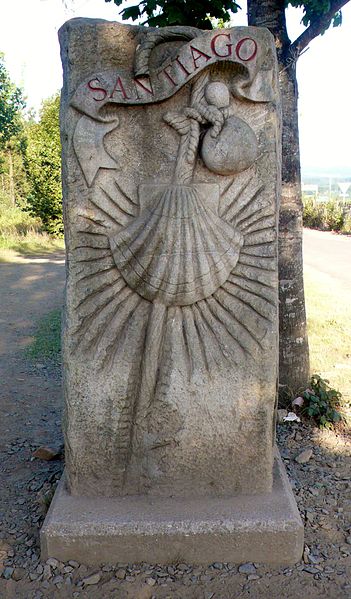Well ... here it is finally we have reached Santiago De Compostela.
Here at the end of the Road we finally can see the connection with the divine Tarot, which was mentioned in one of my earlier posts this month.
Here is the lesson:-
[...] "Father Jordi sat at the table, leaving me standing.
He took some herbs and lit them, filling the place with their perfume.
More and more, the situation reminded me of my encounter with Mme Lourdes.
‘First, I want to tell you something,’ said Father Jordi.
‘The Jacobean route is only one of four roads.
It is the Road of the Spades, and it may give you power, but that is not enough.’
‘What are the other three?’
‘You know at least two others:
the Road to Jerusalem, which is the Road of the Hearts, or of the Grail, and which endows you with the ability to perform miracles;
and the Road to Rome, which is the Road of the Clubs; it allows you to communicate with other worlds.’
‘So what’s missing is the Road of the Diamonds to complete the four suits of the deck,’ I joked.
And the father laughed. ‘Exactly. That’s the secret Road.
If you take it someday, you won’t be helped by anybody.
For now, let us leave that one aside.” [...] (Source: The Pilgrimage by Paulo Coelho)
Christians in the first millennium considered three routes to be sacred.
Each of them offered a series of blessings and indulgences to those who traveled its length.
The first led to the tomb of Saint Peter in Rome; its travelers, who were called wanderers, took the cross as their symbol.
The second led to the Holy Sepulcher of Christ in Jerusalem; those who took this road were called Palmists, since they had as their symbol the palm branches with which Jesus was greeted when he entered that city.
There was a third road, which led to the mortal remains of the apostle, San Tiago – Saint James in English, Jacques in French, Giacomo in Italian, Jacob in Latin.
He was buried at a place on the Iberian peninsula where, one night, a shepherd had seen a brilliant star above a field.
The legend says that not only San Tiago but also the Virgin Mary went there shortly after the death of Christ, carrying the word of the Evangelist and exhorting the people to convert.
The site came to be known as Compostela – the star field – and there a city had arisen that drew travelers from every part of the Christian world.
These travelers were called pilgrims, and their symbol was the scallop shell.
Pedroso mountain, Laraño, Santiago de Compostela, Galicia, Spain
We have succeeded the Road, an equivalent of the Road Jesus had to take on His final days, but here it is not going to stop.
Here at Santiago De Compostela, it starts ... the final piece of life as we know it ... here at Santiago de Compostela, we have seen the Lamb and we have seen our future ...
Here at the end of the Road we finally can see the connection with the divine Tarot, which I mentioned in one of my earlier posts this month ...
We have conquered life and we may enter into the Love our Creator, Higher Spirit or what ever name that you choose for that Power.
Finally, Paulo recovers his sword what was taken from him at the start of his Road to Santiago ... he finally gets it back from his Master.
I need share a short piece of text from "The Pilgrimage" to celebrate that we have, together with Paulo done.
[...] "As the lamb looked at me, I could read all of this in his eyes;
now he had become my guide along the Road to Santiago.
For a moment everything went dark, and I began to see scenes that were reminiscent of those I had read about in the Apocalypse:
the Great Lamb on his throne and people washing his vestments, cleansing them with his blood.
This was the moment when the God was awakened in each of them.
I also saw the wars and hard times and catastrophes that were going to shake the earth over the next few years.
But everything ended with the victory of the Lamb and with every human being on earth awakening the sleeping God and all of God’s power.
I was worthy of my sword because I knew what to do with it." [...] (Source: The Pilgrimage by Paulo Coelho)
[...] "The Master held out the sword to me, and I grasped it.
I looked about for the lamb, but he had disappeared.
But that did not matter:
the Water of Life fell from the sky and caused the blade of my sword to glisten.' [...] (Source: The Pilgrimage by Paulo Coelho)
Tanka - Arriving at the Right Moment
the moment has come
the road to santiago
arriving on time
recovering the lost sword
a small medal to treasure




























